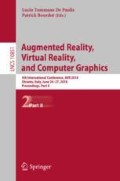Abstract
This article proposes an application of assistance for speech and language therapies, aimed at children suffering from this pathology. The system was implemented in a virtual environment developed with the graphics engine Unity 3D, in order to provide an application that optimizes both the use of materials, infrastructure, time resources, among others. The developed system consists of five games based on Speech and Language Therapy, SLT, which encourage the child to perform the different exercises of the five areas of this disorder, hearing, structure and oral function, linguistic formulation, expressive language and Articulation, receptive language. The proposed tool allows the user to select both the work environment and the level of difficulty during the therapy process.
Access this chapter
Tax calculation will be finalised at checkout
Purchases are for personal use only
References
Rosselli, M., Matute, E., Ardila, A.: Neuropsicología del desarrollo infantil. Editorial El Manual Moderno (2010)
Quevedo, W.X., et al.: Assistance system for rehabilitation and valuation of motor skills. Presented at the International Conference on Augmented Reality, Virtual Reality and Computer Graphics, pp. 166–174 (2017)
Trauner, D.A., Nass, R.D.: Developmental language disorders. In: Swaiman’s Pediatric Neurology, 6th edn., pp. 431–436. Elsevier (2018)
Arocena, J.G., Gallego, M.G., Gimenez, J.V., Guerrero, J.M.: Valoración de la deficiencia y la discapacidad en los trastornos del lenguaje, el habla y la voz. Ministerio de Trabajo y Asuntos Sociales (1997)
Enderby, P., Emerson, J.: Speech and language therapy: does it work? BMJ 312(7047), 1655 (1996)
Tomblin, J.B., Records, N.L., Buckwalter, P., Zhang, X., Smith, E., O’Brien, M.: Prevalence of specific language impairment in kindergarten children. J. Speech Lang. Hear. Res. 40(6), 1245–1260 (1997)
Vargha-Khadem, F., et al.: Neural basis of an inherited speech and language disorder. Proc. Natl. Acad. Sci. 95(21), 12695–12700 (1998)
Mashima, P.A., Doarn, C.R.: Overview of telehealth activities in speech-language pathology. Telemed. E-Health 14(10), 1101–1117 (2008)
Newbury, D.F., Monaco, A.P.: Genetic advances in the study of speech and language disorders. Neuron 68(2), 309–320 (2010)
Ross, K., Heiny, E., Conner, S., Spener, P., Pineda, R.: Occupational therapy, physical therapy and speech-language pathology in the neonatal intensive care unit: patterns of therapy usage in a level IV NICU. Res. Dev. Disabil. 64, 108–117 (2017)
James, D.M.: The applicability of normalisation process theory to speech and language therapy: a review of qualitative research on a speech and language intervention. Implement. Sci. 6(1), 95 (2011)
Robles-Bykbaev, V.E., López-Nores, M., Pazos-Arias, J.J., Arévalo-Lucero, D.: SPELTA: an expert system to generate therapy plans for speech and language disorders. Expert Syst. Appl. 42(21), 7641–7651 (2015)
Fischer, F., Kollar, I., Stegmann, K., Wecker, C.: Toward a script theory of guidance in computer-supported collaborative learning. Educ. Psychol. 48(1), 56–66 (2013)
Naranjo, C.A., et al.: Teaching process for children with autism in virtual reality environments. Presented at the Proceedings of the 2017 9th International Conference on Education Technology and Computers, pp. 41–45 (2017)
Franceschini, S., Gori, S., Ruffino, M., Viola, S., Molteni, M., Facoetti, A.: Action video games make dyslexic children read better. Curr. Biol. 23(6), 462–466 (2013)
Lüke, C.: Impact of speech-generating devices on the language development of a child with childhood apraxia of speech: a case study. Disabil. Rehabil. Assist. Technol. 11(1), 80–88 (2016)
Acknowledgment
The authors would like to thanks to the Corporación Ecuatoriana para el Desarrollo de la Investigación y Academia – CEDIA for the financing given to research, development, and innovation, through the CEPRA projects, especially the project CEPRA-XI-2017-06; Control Coordinado Multi-operador aplicado a un robot Manipulador Aéreo; also to Universidad de las Fuerzas Armadas ESPE, Universidad Técnica de Ambato, Escuela Superior Politécnica de Chimborazo, and Universidad Nacional de Chimborazo, and Grupo de Investigación en Automatización, Robótica y Sistemas Inteligentes, GI-ARSI, for the support to develop this paper.
Author information
Authors and Affiliations
Corresponding authors
Editor information
Editors and Affiliations
Rights and permissions
Copyright information
© 2018 Springer International Publishing AG, part of Springer Nature
About this paper
Cite this paper
Guamán, A., Álvarez V., M., Sánchez, J.S., Andaluz, V.H. (2018). SLT-Game: Support System for Therapies of Children with Communication Disorders. In: De Paolis, L., Bourdot, P. (eds) Augmented Reality, Virtual Reality, and Computer Graphics. AVR 2018. Lecture Notes in Computer Science(), vol 10851. Springer, Cham. https://doi.org/10.1007/978-3-319-95282-6_12
Download citation
DOI: https://doi.org/10.1007/978-3-319-95282-6_12
Published:
Publisher Name: Springer, Cham
Print ISBN: 978-3-319-95281-9
Online ISBN: 978-3-319-95282-6
eBook Packages: Computer ScienceComputer Science (R0)

